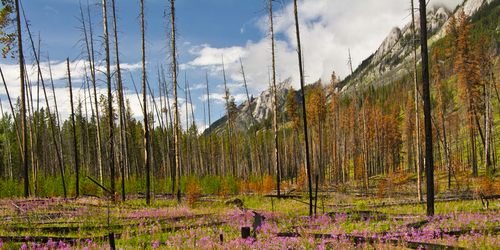New Behaviors from an Old Forest Fire Model
Forest fire models (FFMs) are used to study dynamical relationships between a forest’s density, its growth rate, and how it spreads wildfires. In the 30 years since the first FFM was proposed, researchers have also used the models to explore more generally how complex systems generate “self-organized criticality”—a property of systems including neural networks and solar flares. Now, Diego Rybski, at the Potsdam Institute for Climate Impact Research in Germany, and colleagues have discovered that an FFM from the 1990s displays a self-organizing behavior that has been overlooked for decades [1]. The prediction suggests that novel behaviors might be found in other well-studied models of complex systems.
An FFM is a cellular-automaton-based model in which a forest is approximated by a 2D array of cells, with filled cells indicating areas that contain trees and empty cells indicating areas that are unforested. On each tick of the model’s clock, every empty cell can become forested with a probability p, and every forested cell can suffer a lightning strike with a probability q (q is much smaller than p). A lightning strike triggers a fire that spreads instantaneously from the struck cell to each connected forested cell.
Previous analyses of FFMs searched for self-organized criticality in the relationship between p, q, and the size of the resulting fire. Rybski and his colleagues looked instead at how those variables affect the density of forested cells over time. They discovered that large values of p give rise to forests whose density oscillates between two distinct values. For small values of p, these distinct densities disappear, but quasiperiodic oscillations remain with a frequency approximately proportional to p. The researchers say that such oscillations might appear in real ecosystems that are adapted to periodic burning.
–Marric Stephens
Marric Stephens is a Corresponding Editor for Physics Magazine based in Bristol, UK.
References
- D. Rybski et al., “Self-organized multistability in the forest fire model,” Phys. Rev. E 104, L012201 (2021).




